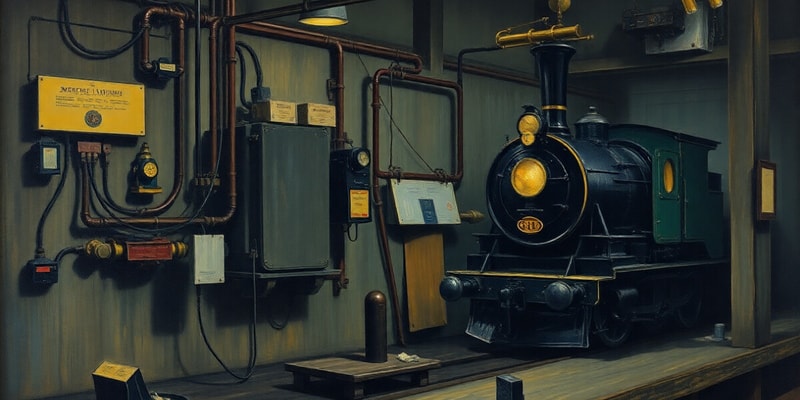Podcast
Questions and Answers
Who is responsible for resealing metal to carbon contact type relays if seals are broken?
Who is responsible for resealing metal to carbon contact type relays if seals are broken?
What should be done when high contact resistance is observed on a relay contact during inspection?
What should be done when high contact resistance is observed on a relay contact during inspection?
What material issues should be regularly checked for during relay maintenance?
What material issues should be regularly checked for during relay maintenance?
Who is primarily responsible for inspecting relays used in vital circuits?
Who is primarily responsible for inspecting relays used in vital circuits?
Signup and view all the answers
What indicates that maintenance is needed for a relay?
What indicates that maintenance is needed for a relay?
Signup and view all the answers
What should trigger taking a relay out of service during a visual inspection?
What should trigger taking a relay out of service during a visual inspection?
Signup and view all the answers
How long should metal to carbon contact miniature plug-in relays be used before replacement?
How long should metal to carbon contact miniature plug-in relays be used before replacement?
Signup and view all the answers
Which defect does not necessitate the immediate removal of a relay from service?
Which defect does not necessitate the immediate removal of a relay from service?
Signup and view all the answers
What is the maximum recommended usage period for plug-in type track relays?
What is the maximum recommended usage period for plug-in type track relays?
Signup and view all the answers
Which abnormal condition is cited as a reason for taking a relay out of service?
Which abnormal condition is cited as a reason for taking a relay out of service?
Signup and view all the answers
What environmental conditions should relays not be stored near?
What environmental conditions should relays not be stored near?
Signup and view all the answers
What is a necessary precaution when transporting relays?
What is a necessary precaution when transporting relays?
Signup and view all the answers
What should not be changed in 'Q' style relays to maintain safety?
What should not be changed in 'Q' style relays to maintain safety?
Signup and view all the answers
How many contacts can exist in a circuit without exceeding voltage drop considerations?
How many contacts can exist in a circuit without exceeding voltage drop considerations?
Signup and view all the answers
What is the minimum voltage that should be maintained across R1 and R2 of a relay?
What is the minimum voltage that should be maintained across R1 and R2 of a relay?
Signup and view all the answers
What feature should a relay room have for security?
What feature should a relay room have for security?
Signup and view all the answers
Which component should be checked for proper locking when a relay is plugged in?
Which component should be checked for proper locking when a relay is plugged in?
Signup and view all the answers
What must be prepared to assist in locating relays easily?
What must be prepared to assist in locating relays easily?
Signup and view all the answers
What type of relays should be used for LED signal lamps?
What type of relays should be used for LED signal lamps?
Signup and view all the answers
Which feature is essential for plug-in relays to prevent incorrect installation?
Which feature is essential for plug-in relays to prevent incorrect installation?
Signup and view all the answers
When using electronic time element relays, how many relays should be utilized in the circuit?
When using electronic time element relays, how many relays should be utilized in the circuit?
Signup and view all the answers
What is a crucial design consideration for circuits using magnetic latch relays?
What is a crucial design consideration for circuits using magnetic latch relays?
Signup and view all the answers
What should be ensured when using metal to metal contact relays?
What should be ensured when using metal to metal contact relays?
Signup and view all the answers
How much spare working contacts should be available for relays, excluding track relays?
How much spare working contacts should be available for relays, excluding track relays?
Signup and view all the answers
Which type of relay is recommended for flasher circuits?
Which type of relay is recommended for flasher circuits?
Signup and view all the answers
Study Notes
Relays - General Requirements
- Approved plug-in line relays (neutral/polar biased/magnetic latch/interlocked type) rated at 24/48/60 V DC are typically used. Approved LED lamp proving relays should be used for LED signal lamps.
- Approved relay types are used in RE and non-RE areas. Various relay types used in signaling are detailed in Annexure 21-A1.
- Approved time element relays must be used. If electronic time element relays are used, two should be present in the circuit, with their contacts in series.
- Track relays located in track side location boxes should be a plug-in type.
- All plug-in relays/relay groups should have a coding pin arrangement to prevent incorrect installation during replacements. All relays/groups should be sealed.
- Relays should be housed in the relay room of the controlling cabin to maximize centralization.
- Ensure sequential proving of front and back contacts for metal-to-metal contact relays.
- Replacing plug-in relays/groups during operation should not create unsafe conditions in circuits.
- Relays, excluding track relays, should have spare contacts (10% of working contacts), with a minimum of one front and one back spare, to allow future circuit alterations. Relay racks should have additional space (min 10%) for future repeater relays.
- If magnetic latch relays are utilized, the design should prevent the relay from dropping due to back EMF from other relays.
- 'Q' type relays should preferably use flexible multi-strand wiring with parallel connections, where possible.
Fixing in Relay Room
- Relay rooms should be located away from chemical factories, locomotive sheds, and ash pits, wherever possible.
- Safety measures should be taken to safeguard relays from chemical fumes, dust, etc., if unavoidable.
- The room should have double locks and door monitoring (e.g., through a Datalogger).
- Relays that cannot be housed in the cabin should use approved location boxes.
- "Q" style relay code pin configurations should not be altered. Siemens K-50 relays should keep the code pin positions consistent with the manufacturer's design.
- Ensure correct locking of all relay clips when installing plug-in type relays.
- An index board for relay identification should be provided.
- Relays with external circuits should have cross-protection (double cutting). Preference should be given to double cutting for signal control relays.
- Prepare and maintain a contact analysis chart, documenting contacts, circuits, spares, and wire count. Ensure the voltage across R1 & R2 is 22V or greater.
- Use paralleled working spare contacts, where possible.
Sealing of Plug-in Relays
- Metal-to-carbon contact relays should be sealed in the manufacturer's facility initially, and re-sealed in the workshop if repairs necessitate seal breach.
- Metal-to-metal contact relays should have their covers sealed by a trained technician (level JE/Signal).
- Line Relays should be energized to the specified rated voltage per the specifications.
Maintenance of Relays
- Regular cleaning is necessary to prevent dust accumulation.
- Terminals and plug-in connections should be correctly tightened to prevent loose connections.
- Relay components should be visually checked for signs of arcing, pitting, charring, dust accumulation, corrosion, crack/breakage, and presence of fungi or foreign materials.
- Replace relays if high contact resistance is detected during inspections.
Periodical Inspection of Relays
- Inspect relays frequently and specifically those used in major circuits.
- Relay inspection should include checking for armature movement, contact wiping, arcing, pitting/charring of contacts, dust accumulation, electroplating, and corrosion.
- Presence of fungi, dust inside the casing, corrosion of labels, absence or damage to relay retaining clips should be examined.
- Any abnormal conditions should be noted.
Relay Replacement
- Metal-to-carbon contact miniature plug-in relays should not be repaired; they should be replaced after 25 to 30 years or sooner if there is failure.
- Track relay type should be replaced after 12 years or sooner if inspection indicates necessary replacement.
Studying That Suits You
Use AI to generate personalized quizzes and flashcards to suit your learning preferences.
Related Documents
Description
This quiz covers the general requirements and specifications for various types of relays, including plug-in line relays and time element relays. It emphasizes the importance of approved relay types used in different environments and operational protocols to ensure safety and functionality. Test your knowledge on relay standards and proper installation techniques.




